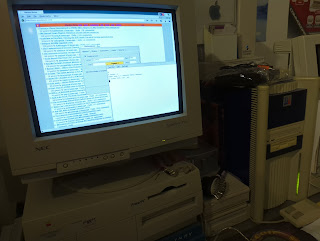This particular machine is a fairly upgraded unit thanks in large part to Stephen Dowdy, formerly of the Solbourne Shack and the University of Colorado, where he maintained them. In particular, besides tons of OS stuff and documentation, the SBus RAM expander card giving this machine a total of 56MB ECC RAM came from his old S3000, and it also has a SCSI2SD along with a 256K L2 cache CPU module stolen from an S4100. The 1152x900 monochrome display is compatible with the SBus bwtwo. Just like I retain a great fondness for PA-RISC because it was my first job out of college, I have similar affection for Solbournes because one of my first undergraduate Unix accounts was on a department Series6.
KAP was an interesting processor with a great name, but its sometimes serious issues more or less directly led to Solbourne's demise as a computer manufacturer because Matsushita wouldn't let them walk away from its sunk design costs. Still, it was good competition when it was new and OS/MP was nearly 100% compatible with SunOS 4.x (4.1C, the final release, is equivalent with SunOS 4.1.3), so what you're really looking at is a SPARCstation "clone" of sorts with the hottest display this side of a Al Gore climate chart.
And it turns out that particular computing environment was really the intersection point for a lot of early GUI efforts, which were built and run on Sun workstations and thus will also run on the Solbourne. With some thought, deft juggling of PATH and LD_LIBRARY_PATH and a little bit of shell scripting, it's possible to create a single system that can run a whole bunch of them. That's exactly what reykjavik, this S3000, will be doing.






